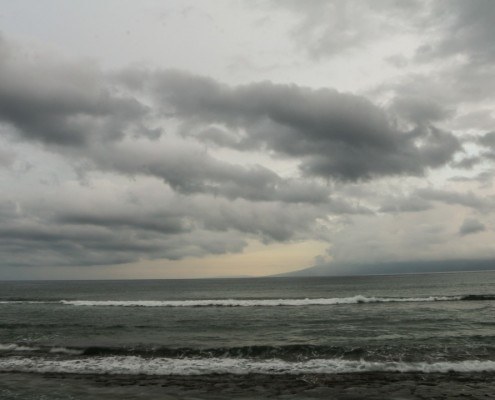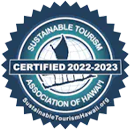
What’s the Weather Like In Maui?
The weather is generally really awesome here on the island of Maui. We have great weather for everyone. Those who love the sun and heat, Kihei & Lahaina are for you. Those that want to live a bit cooler life head for Kula while those who donʻt mind the rain are happily residing in Haiku.
For those of you who are on vacation, there are a few tips you need to learn about the weather on Maui.
Tip #1: Itʻs All About The Location
Look to the weather where you are going, based upon when you plan to be at that location. The weather could be cloudy on the north side of the island and sunny on the south facing sides.
Tip #2: Weather Gives The Island Diversity & Character
There are 11 life zones on the island due to the size of our volcanos and the amount of moisture being driven against them. The trade winds blowing in from the north-east drive nutrient rich air and moisture up creating pockets of unique life unlike anywhere else in the world.
Tip #3: As You Go Up The Temperature Goes Down
Elevation makes a difference. Planning to go up the mountain? Upcountry Maui is at least a few degrees cooler than Lahaina or Kihei. The summit can be around 30 degrees or lower.
Tip #4: Rainy Days Can Be Great Days On The Road To Hāna
Our small watershed that feeds streams in our beautiful gulches is dependent on a constant, near-daily rainfall. When larger rain systems come through, the waterfalls get even bigger for short periods making for even more spectacular pictures, although hiking becomes more dangerous.
Maui Weather Forecast
The thing about Maui is that the weather is never what it really says on the forecasts. The island massive volcano, Haleakalā shapes the weather patterns and creates a number of amazing life zones due to the rainfall.
When looking to get a clear idea of what the weather is like, you need to know where you are going and whatʻs the normal pattern. A rainy day on the road to Hana is a usual thing. What really matters is how hard it will fall and for how long.
For seeing a beautiful sunrise, clouds really make a difference. The legendary rays of the Sun being held down in the crater is perfectly illustrated when itʻs not perfectly clear out to the east.
To get a clear picture of the weather you are dealing with, figure out where you are going and check the radar and other tools below.
Hawaiiʻs Rainy Season
Choosing The Right Season For Your Vacation
There is a joke on some parts of the island (like in Haiku,Maui) when a visitor asks the question; When is the rainy season here? The answer: Everyday, even when itʻs sunny itʻs raining here…
To plan the best vacation, you want to go during the right season. This is true for many other vacation hot-spots around the world but not so much for Maui.
The rainy season in general terms is from about November thru to March. The land is greener with temperatures being a little cooler overall. This doesnʻt mean that there is more rainy-days in places where you will spend most of your time. The rains might happen a bit more often and more overnight showers will occur.
During the non-rainy season, especially June thru to October, the rain that does come in tend to be larger and more destructive. This time also includes our Hurricane season. Named storms do not occur as often out here in the Pacific like they do in the Caribbean making visits to Hawaii a more risk-free adventure.
Q: When is Huricane Season In Hawaii?
A: June Thru To November
Q: What Months Are The Best Time To Visit?
A: This is a tough question to answer as there is something to do in every season. The popular times when more people are on the island means that there are simply more things to enjoy during that time period (like when the whales are here) while the quieter times of the year have the appeal of having secluded beaches and island destinations to yourself.
Q: What do you do on a rainy day on Maui?
A: Based on the weather patterns, unless itʻs a tropical storm or hurricane near, the weather wonʻt be the same all over the island. If you want to find different weather all it takes it a short drive around the mountains. The best thing about a rainy day is that it creates waterfalls. Lots and lots of waterfalls. This makes a tour on the road to Hāna the thing to do!
Q: Does a clear sky make a better sunrise / sunset?
A: There is nothing like a Maui sunrise and viewing it from the top of Haleakalā is the way to go. A clear sky is nice as it allows you to see the stars better before sunrise and after sunset. This normally happens when you look straight up. Clouds add a layer of beauty as they reflect amazing colors; dark reds, hot pinks, and pumpkin oranges. It creates a scene that you will remember forever. Having a bit of weather, clouds moving through during a sunrise or sunset is a regular occurrence.
Q: Where can I find the best weather on Maui?
A: We love our sunny weather, comfortably warm temperatures, nice breezes and not too humid. That describes pretty much most of Maui that visitors will stay in. Your hotel or condo will be situated in the best place for that area and style. Most hotels and condos are in South Maui (Kihei & Wailea) or West Maui (Lahaina, Kaanapali, Honokawai, Napili, Kapalua)
Those who like a little adventure (rain or cold weather) with their vacation experience would be more inclined to stay in Haiku, Upcountry Maui or even Hana.
Mauiʻs Historical Weather Timeline
Mauiʻs weather varies about 20 degrees Fahrenheit or about 12 degrees Celsius in any one area where most people tend to live or vacation throughout the year. The weather will be a bit more extreme in the places you will want to visit. The summit will get snow in the winter months.
The average high in Haleakalā National Park during the day is about 63F (17C) while in Lahaina the high is 85F (30C).
Below is a timeline of some major storms that have had an impact on Maui over the past century. There hasnʻt been a hurricane to strike the island in recorded history. A hurricane came close to ruining vacations plans once (about 145 years ago) so your vacation plans are much safer than most Carribean and Central American destinations.
- 1871
- Hurricate – Made Landfall in Hawaii
- 1966
- Hurricane Connie – No Landfall With Heavy Rain
- 1967
- Tornado – $2500 in Damages
- 1971
- Severe Storm – Flooding & Tornadoes
- 1982
- Hurricane Iwa
- 1978
- Hurricane Fico – 15 Feet Waves Created
- 1986
- Hurricane Estelle – High Surf
- 1991
- Hurricane Fefa – Strong Winds & Flooding
- 1993
- Hurricane Fernanda – 15 Feet Waves
- 2006
- F0 Tornado – No Damage Reported
- 2018
- Hurricane Lane – Heavy rains, debris caused fires, flash flooding
Notable Hurricanes & Storms
Hurricane – 1871
This is the best guess of the path of the hurricane that was recorded in Hawaiian Newspapers back in 1871. Since 1834, Hawaiian language newspapers were an important tool for later education, providing insights into natural disasters in the 1900s and before.
Hurricane Iniki – 1992
The last major hurricane to hit the Hawaiian Islands was Iniki in 1992. It was the September 11th, the 9/11, for the people of Kauai causing over a billion dollars in damages. Thankfully only 6 lives were lost. This destructive force caused scars in the landscape and the people that were still felt 10 years later.
This category 4 storm, the most powerful storm to hit Hawaii directly, came right after one of the most destructive storms to hit the USA, Hurricane Andrew (category 5) in the Atlantic which devastated Florida and Louisiana in late August 1992.
Storm Watch, Warning & Advisories
Tropical Storm Warning – Tuesday September 11th, 9:30pm HST – For Next 7 Hours
TROPICAL STORM WARNING REMAINS IN EFFECT FOR THE WAILUKU, WAIHEE AND KAPALUA AREAS OF WEST MAUI. THE NATIONAL WEATHER SERVICE ASKS YOU TO PLAN FOR 58-73 MPH WINDS AND FLASH FLOODING IN RANGES FROM DEVASTATING TO CATASTROPHIC.
Preparing For A Tropical Storm Or Hurricane On Maui
WHAT TO DO DURING A TROPICAL STORM
Like any storm, you need to be extra careful when walking around outside. There may be damage to local trees, power lines and fencing causing hazards. There will be flood waters and less than 6 inches of moving water can knock you down or pull a car off the road. Donʻt go into any gulches.
6 HOURS BEFORE ARRIVAL
Turn the fridge and freezer to the coldest setting so that if power is lost, food will stay cooler longer. Make sure all shutters or vulnerable windows have been protected. Make sure your chainsaw is ready to go and your 4×4 is ready to go out to help afterwards.
6-12 HOURS BEFORE ARRIVAL
Charge all your devices and make sure you have a way to check for the latest weather and safety updates.
THE DAY BEFORE A STORM ARRIVAL
You need to have your plan in place in the event that your family is separated, lose power or are cut off due to flood waters or fallen trees. Make sure you have your emergency kit all stocked up again, that there is plenty of gas in the car and you have food and water for at least 3 days for a tropical storm and 7 days for a hurricane.
It would be a good time to take all the items off the lanai that could blow away and secure any other yard items. Clear debris from the storm drains.








